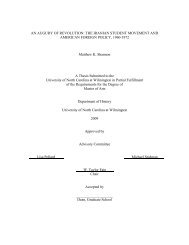Saprolegnia - The iLumina Digital Library
Saprolegnia - The iLumina Digital Library
Saprolegnia - The iLumina Digital Library
You also want an ePaper? Increase the reach of your titles
YUMPU automatically turns print PDFs into web optimized ePapers that Google loves.
Among the species of <strong>Saprolegnia</strong> with eccentric oospores, S. eccentrica is easily<br />
recognized because it lacks antheridial branches (Figs. 101 A-C). Its chief characteristics<br />
are shared with S. richteri, save for the presence of antheridia in the latter. We have not<br />
seen specimens of S. richteri, but should the presence or absence of antheridial branches<br />
prove to be variable, S. richteri properly would be merged with S. eccentrica. Like S.<br />
eccentrica, S. luxurians has predominantly one oospore in the oogonium; the latter has<br />
larger oospores (and oogonia) than the former, and possesses a well-developed<br />
antheridial apparatus.<br />
Dick (1960c: fig. 3 H-K) figures subeccentric oospores for Isoachlya (=<strong>Saprolegnia</strong>)<br />
eccentrica. None of the oospores in the specimens of S. eccentrica that we have examined<br />
possessed such a refractive body disposition pattern, and certainly Coker (loc. cit.) had<br />
described and illustrated the oospores of I. eccentrica as eccentric. It is possible that Dick<br />
had at hand another species. Although V. D. Matthews (1935) reported seeing<br />
internally proliferated sporangia (saprolegnoid renewal), in specimens of I. eccentrica,<br />
Coker (loc. cit.) had earlier stated that his species never displayed such a pattern.<br />
CONFIRMED RECORDS: -- BRITISH ISLES: O’Sullivan (1965:301, fig. II-36-48).<br />
CANADA: Maestres (1977:146). CZECHOSLOVAKIA: Cejp (1959a:198, fig. 70).<br />
POLAND: Staniak (1971:362). UNITED STATES: Coker (loc. cit.); V. D. Matthews<br />
(1935:307); Seymour (loc. cit.). USSR: Morochkovs’kiĭ et al. (1967:132, fig. 117).<br />
RECORDED COLLECTIONS: -- BRITISH ISLES: Cook and Morgan (1934); Dick<br />
(1962, 1963); Dick and Newby (1961); Hunter (l975). CANADA: Maestres and Nolan<br />
(1978). GERMANY: Höhnk (1935a). INDIA: J. N. Rai and Misra (1977b:76, fig. 3a).<br />
JAPAN: Suzuki (1960c). UNITED STATES: R. L. Butler (1975: figs. 17-20); Coker (1927);<br />
J. V. Harvey (1925a, b; 1927b, c; 1930); G. C. Hughes (1959, 1962); Klich (1980); V. D.<br />
Matthews (1927); A. W. Ziegler (1958b).<br />
SPECIMENS EXAMINED: -- SWEDEN (1), TWJ. UNITED STATES (14), RLS.<br />
Centraalbureau (1).<br />
<strong>Saprolegnia</strong> richteri Richter ex Seymour<br />
Nova Hedwigia (Beiheft) 19:53. 1970<br />
Isoachlya terrestris Richter, Flora 131:242, figs. 5, 6. 1937.<br />
Cladolegnia terrestris (Richter) Johannes, Feddes Repert. Spec. Nov. Regni Veg., p. 216.<br />
1955.<br />
Monoecious. Hyphae delicate, sparingly branched. Sporangia cylindrical or<br />
slightly irregular, or fusiform and tapering toward the apex; producing lateral,<br />
cylindrical or fusiform branches; renewed internally or by sympodial branching; 293-<br />
543 x 25-44 µm. Spores apparently dimorphic; discharge and behavior saprolegnoid;<br />
primary() spore cysts 8-10 µm in diameter. Gemmae unknown. Oogonia lateral;<br />
globose, seldom somewhat irregular; 32-44 µm in diameter. Oogonial wall unpitted;<br />
645
















